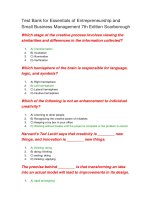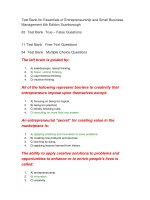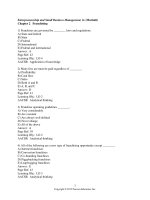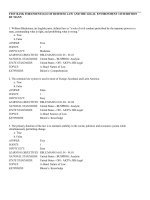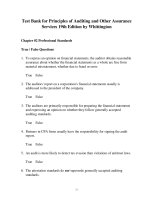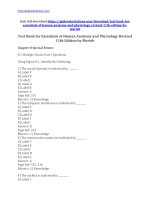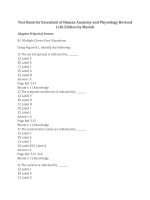126 test bank for essentials of entrepreneurship and small business management 7th edition scarborough
Bạn đang xem bản rút gọn của tài liệu. Xem và tải ngay bản đầy đủ của tài liệu tại đây (159.18 KB, 27 trang )
Test Bank for Essentials of Entrepreneurship and
Small Business Management 7th Edition Scarborough
Which stage of the creative process involves viewing the
similarities and differences in the information
collected?
1.
2.
3.
4.
A) Transformation
B) Incubation
C) Illumination
D) Verification
Which hemisphere of the brain is responsible for language,
logic, and symbols?
1.
2.
3.
4.
A) Right hemisphere
B) Left hemisphere
C) Lateral hemisphere
D) Intuitive hemisphere
Which of the following is not an enhancement to individual
creativity?
1.
2.
3.
4.
A) Listening to other people
B) Recognizing the creative power of mistakes
C) Keeping a toy box in your office
D) Working without breaks until the project is complete or the problem is solved
Harvard's Ted Levitt says that creativity is ________ new
things, and innovation is ________ new things.
1.
2.
3.
4.
A) thinking; doing
B) doing; thinking
C) seeing; doing
D) thinking; applying
The premise behind ________ is that transforming an idea
into an actual model will lead to improvements in its
design.
1.
2.
3.
4.
A) rapid prototyping
B) mind-mapping
C) brainstorming
D) inventions
Creativity often involves creating something from nothing.
However, it is more likely to result in:
1.
A) elaborating on the present.
2.
3.
4.
B) putting old things together in new ways.
C) taking something away to create something simpler or better.
D) All of the above
This set of experiences may enhance individual creativity.
1.
2.
3.
4.
A) Travel and recognize the creative power of mistakes and accidents
B) Notice what is missing
C) Journal and listen to people and customers
D) All the above
Research into the operation of the human brain shows that
each hemisphere of the brain:
1.
2.
3.
4.
A) develops symmetrically.
B) controls similar functions.
C) does not dominate the other hemisphere.
D) processes information differently.
All of the following represent barriers to creativity that
entrepreneurs impose upon themselves except:
1.
2.
3.
4.
A) focusing on being too logical.
B) being too practical.
C) blindly following rules.
D) searching for more than one answer.
When developing creative solutions to modern problems,
entrepreneurs must:
1.
2.
3.
4.
A) go beyond merely using whatever has worked in the past.
B) limit the creative process to only profitable ventures.
C) remember what has worked in the past.
D) pay attention to limiting factors.
Which hemisphere of the brain processes information all at
once and by relying heavily on images?
1.
2.
3.
4.
A) Right hemisphere
B) Left hemisphere
C) Vertical hemisphere
D) Logical hemisphere
The left brain is guided by:
1.
2.
3.
4.
A) kaleidoscopic, lateral thinking.
B) linear, vertical thinking.
C) asymmetrical thinking.
D) intuitive thinking.
The ability to apply creative solutions to problems and
opportunities to enhance or to enrich people's lives is
called:
1.
2.
3.
4.
A) entrepreneurship.
B) innovation.
C) creativity.
D) creative thinking.
Which stage of the creative process includes on-the-job
training?
1.
2.
3.
4.
A) Implementation
B) Preparation
C) Illumination
D) Verification
To protect patent claims, an inventor should be able to verify
and document the:
1.
2.
3.
4.
A) research conducted to create the invention.
B) fact that the invention was created in another country.
C) date on which the idea was first conceived.
D) initial sales of the invention.
All of the following are enhancements to individual creativity
except:
1.
2.
3.
4.
A) keeping a journal to record thoughts and ideas.
B) limiting your reading sources.
C) taking time off.
D) allowing yourself to be creative.
An entrepreneurial "secret" for creating value in the
marketplace is:
1.
2.
3.
4.
A) applying creativity and innovation to solve problems.
B) creating new products and services.
C) learning by doing.
D) applying lessons learned from history.
________ lateral thinking is somewhat unconventional and
unstructured.
1.
2.
3.
4.
A) Left-brained
B) Right-brained
C) Systematic
D) Logical
During the incubation phase of the creative process, the
entrepreneur might do all of the following EXCEPT
which one to let ideas "marinate" in his mind?
1.
2.
3.
4.
A) Do something totally unrelated for awhile.
B) Relax and play regularly.
C) Work on the problem or opportunity in a different environment.
D) Don't allow one's self to daydream.
The ability to see the similarities and the connections among
various data and events is called:
1.
2.
3.
4.
A) convergent thinking.
B) divergent thinking.
C) transformational thinking.
D) illumination.
The technique of ________ uses three columns that allows
the entrepreneur to weigh both the advantages and the
disadvantages of a particular decision and work to
maximize the variables that support it while minimizing
those that work against it.
1.
2.
3.
4.
A) force-field analysis
B) TRIZ
C) brainstorming
D) mind mapping
________ is necessary for building a competitive advantage
and for business survival.
1.
2.
3.
4.
A) One single idea
B) A motivated owner
C) Creativity
D) A low-priced product
The ability to develop new ideas and to discover new ways of
looking at problems and opportunities is called:
1.
2.
3.
4.
A) entrepreneurship.
B) innovation.
C) creativity.
D) creative thinking.
Employees must be given the tools and resources they need
to be creative. One of the most valuable set of
resources is:
1.
A) setting limits and providing challenges.
2.
3.
4.
B) establishing rules and guidelines.
C) time, support and encouragement.
D) reinforce traditional problem solving methods.
________ is a graphical technique that encourages thinking
on both sides of the brain, visually displays the
various relationships among the ideas, and improves
the ability to view a problem from many sides.
1.
2.
3.
4.
A) Brainstorming
B) Mind-mapping
C) Prototyping
D) Groupthink
The right brain is guided by:
1.
2.
3.
4.
A) kaleidoscopic, lateral thinking.
B) linear, vertical thinking.
C) asymmetrical thinking.
D) logical thinking.
Research shows that anyone can learn to be creative. The
problem is:
1.
2.
3.
4.
A) many organizations fail to foster an environment that encourages creativity.
B) most people never tap into their pools of innate creativity.
C) most people have never been taught to be creative.
D) All of the above
The ________ environment has an impact on the level of
people's creativity.
1.
2.
3.
4.
A) physical
B) sounds in the
C) external
D) internal
The focus of this step in the creative process is to transform
the idea into reality.
1.
2.
3.
4.
A) Implementation
B) Preparation
C) Illumination
D) Verification
Which hemisphere of the brain is responsible for the body's
emotional, intuitive, and spatial functions?
1.
2.
3.
A) Right hemisphere
B) Left hemisphere
C) Vertical hemisphere
4.
D) Logical hemisphere
Steps in the patent process include:
1.
2.
3.
4.
A) establishing whether it is a novelty.
B) documenting and verifying the date the idea was first conceived.
C) searching existing patents.
D) All of the above
________ vertical thinking is narrowly focused and
systematic, proceeding in a highly logical fashion from
one point to the next.
1.
2.
3.
4.
A) Left-brained
B) Right-brained
C) Unconventional
D) Intuitive
To which governmental office must applications for patents
be submitted?
1.
2.
3.
4.
A) The U.S. Patent and Trademark Office
B) The individual State Offices of Patent Development
C) The Federal Trade Commission
D) The Securities and Exchange Commission
Any distinctive word, phrase, symbol, name, or logo a firm
uses to distinguish itself or its products is called a:
1.
2.
3.
4.
A) trademark.
B) patent.
C) copyright.
D) service mark.
________ thinking is the ability to see similarities and
________ thinking is the ability to see differences
among various data and events.
1.
2.
3.
4.
A) Divergent; convergent
B) Convergent; divergent
C) Convergent; transformational
D) None of the above
Entrepreneurs can stimulate their own creativity and
encourage it among workers by:
1.
2.
3.
4.
A) expecting and tolerating failure.
B) avoiding problems.
C) limiting rewards.
D) not taking chances.
"Verification" refers to:
1.
2.
A) validating the idea as accurate and useful.
B) possibly conducting experiments, running simulations, and test marketing a
product or service.
3. C) possibly asking questions such as "will it work?" and "is it really a better
solution?"
4. D) All of the above
More than ________ percent of those holding patents win
their infringement suits.
1.
2.
3.
4.
A) 15
B) 30
C) 45
D) 60
________ is a process in which a small group of people
interacts to produce a large quantity of imaginative
ideas.
1.
2.
3.
4.
A) Groupthink
B) Mind-mapping
C) Brainstorming
D) Prototyping
Entrepreneurship is a constant process that relies on:
1.
2.
3.
4.
A) creativity, innovation, and profit.
B) the ability to win over the consumer.
C) creativity, innovation, and application in the marketplace.
D) intellectual property rights.
The three principles (three Rs) of rapid prototyping are:
1.
2.
3.
4.
A) develop a rough model, rapidly, and for the right price.
B) develop a complete model, rapidly, and for the right problem.
C) develop a rough model, rapidly, and for the right problem.
D) develop a right model, roughly, for the right price.
Which hemisphere of the brain processes information in a
step-by-step fashion?
1.
2.
3.
4.
A) Right hemisphere
B) Left hemisphere
C) Lateral hemisphere
D) Intuitive hemisphere
Copyrights protect the creator of original works such as:
1.
2.
A) software, choreography, and motion pictures.
B) symbols, names, and designs.
3.
4.
C) text and verbiage of any kind.
D) slogans and designs.
Mind-mapping is a useful tool for jump-starting creativity. It
includes all of the following except:
1.
A) sketching a picture to symbolize the problem or area of focus in the center of a
sheet of paper.
2. B) writing down every idea that comes into your mind, connecting each idea to the
central picture.
3. C) allowing your mind to rest for a few minutes before integrating the ideas.
4. D) forcing creativity when ideas start to trickle.
Hiring a diverse workforce:
1.
2.
3.
A) helps in enhancing organizational creativity.
B) allows for different ideas and varying methods of problem solving.
C) brings in people from different backgrounds, with different cultural experiences,
hobbies, and interests.
4. D) All of the above
Which stage of the creative process requires one to develop
a solid understanding of the problem or decision?
1.
2.
3.
4.
A) Investigation
B) Preparation
C) Illumination
D) Verification
The "theory of inventive problem solving" is a left-brained,
scientific, systematic process based on innovative
patents and is referred to as:
1.
2.
3.
4.
A) JIT.
B) RP.
C) TQM.
D) TRIZ.
Which of the following is not one of the ways entrepreneurs
can stimulate their own creativity and encourage it
among their workers?
1.
2.
3.
4.
A) Provide creativity training.
B) Encourage curiosity.
C) View challenges as problems.
D) Develop a corporate culture that both fosters and rewards creativity.
A ________ is an exclusive right that protects the creators of
original works such as literary, dramatic, musical, and
artistic works.
1.
2.
3.
4.
A) trademark
B) patent
C) copyright
D) service mark
Effective brainstorming involves all of the following except:
1.
2.
3.
4.
A) a small group of people.
B) an open, uninhibited environment.
C) an effective method to evaluate ideas.
D) very little structure.
Which of the following questions should you consider before
entering a lawsuit to protect intellectual property?
1.
2.
3.
A) Can you afford the loss of time, money, and privacy the lawsuit will bring?
B) Can the opponent afford to pay if you win?
C) Do you expect to get enough from the suit to pay for the costs of hiring an
attorney?
4. D) All of the above
The ability to see the differences among various data and
events is called:
1.
2.
3.
4.
A) convergent thinking.
B) divergent thinking.
C) transformational thinking.
D) illumination.
At which stage of the creative process does a spontaneous
breakthrough occur, allowing all of the previous stages
to come together to produce the "Eureka factor" or the
"light bulb goes on"?
1.
2.
3.
4.
A) Implementation
B) Preparation
C) Illumination
D) Verification
64 Free Test Bank for Essentials of Entrepreneurship
and Small Business Management 7th Edition
Scarborough True - False Questions Page 1
For every 3,000 new product ideas, four make it to the
development stage, two are actually launched, and
only one becomes successful in the market.
1.
2.
True
False
Research shows that each hemisphere of the human brain
processes information differently and that one side of
the brain tends to be dominant over the other.
1.
2.
True
False
A paradigm is a preconceived idea of what the world is, what
it should be like, and how it should operate and this
can influence creativity.
1.
2.
True
False
The right brain processes information in a step-by-step
fashion.
1.
2.
True
False
Innovation must be a constant process because most ideas
do not work and most innovations fail.
1.
2.
True
False
Successful entrepreneurship requires left-brain thinking.
1.
2.
True
False
The right brain relies on kaleidoscopic, lateral thinking.
1.
2.
True
False
The right brain takes care of the body's emotional, intuitive,
and spatial functions.
1.
2.
True
False
The left brain relies on kaleidoscopic, lateral thinking.
1.
True
2.
False
The right brain processes information intuitively-all at once,
relying heavily on images.
1.
2.
True
False
Innovation is the ability to apply creative solutions to
problems and opportunities to enhance or enrich
people's lives.
1.
2.
True
False
The left brain processes information in a step-by-step
fashion.
1.
2.
True
False
Entrepreneurs need to rely on left-brain thinking to generate
innovative product, service, or business ideas and use
right-brain thinking to judge the market potential of the
ideas they generate.
1.
2.
True
False
While most people see what they have always seen, creative
entrepreneurs are able to see beyond preconceptions.
1.
2.
True
False
Entrepreneurs must embrace traditional assumptions and
perspectives about how things ought to be because
they support creativity.
1.
2.
True
False
Although creativity sometimes involves generating
something from nothing, it more likely results in
elaborating on the present, putting old things together
in new ways, or taking something away to create
something simpler or better.
1.
2.
True
False
Creativity and innovation are the signature of small,
entrepreneurial businesses.
1.
2.
True
False
Creativity and innovation are the signature of large,
entrepreneurial businesses.
1.
2.
True
False
History is always a reliable predictor of the future of
business.
1.
2.
True
False
Entrepreneurship requires both left- and right-brained
thinking.
1.
2.
True
False
Creativity is the ability to apply creative solutions to
problems and opportunities to enhance or enrich
people's lives.
1.
2.
True
False
The left brain handles language, logic, and symbols.
1.
2.
True
False
Successful entrepreneurs come up with ideas and then find
ways to make them work to solve a problem or fill a
need.
1.
2.
True
False
The right brain is guided by linear, vertical thinking.
1.
2.
True
False
The left brain processes information intuitively-all at once,
relying heavily on images.
1.
True
2.
False
Right-brained individuals tend to challenge tradition,
custom, and routine.
1.
2.
True
False
Creativity is not only an important source for building a
competitive advantage, but it also is necessary for
survival.
1.
2.
True
False
Creativity is the ability to develop new ideas and to discover
new ways of looking at problems and opportunities.
1.
2.
True
False
Right-brain thinking draws on the power of divergent
reasoning, which is the ability to create a multitude of
original, diverse ideas, while left-brain thinking counts
on convergent reasoning, the ability to evaluate
multiple ideas and choose the best solution to a given
problem.
1.
2.
True
False
The left brain is guided by linear, vertical thinking.
1.
2.
True
False
Creative thinking involves research into the operation of the
human brain and the roles each hemisphere of the
brain plays.
1.
2.
True
False
Innovation is the ability to develop new ideas and to discover
new ways of looking at problems and opportunities.
1.
2.
True
False
64 Free Test Bank for Essentials of Entrepreneurship
and Small Business Management 7th Edition
Scarborough True - False Questions Page 2
"Convergent thinking" is the ability to see the differences
among data and events.
1.
2.
True
False
The rapidly accelerating rate of change has created an
environment in which staying in a leadership position
requires constant creativity, innovation, and
entrepreneurship.
1.
2.
True
False
The major problem with relying on the legal system to
enforce ownership rights is the cost of infringement
lawsuits, which can quickly exceed the budget of most
small businesses.
1.
2.
True
False
During a brainstorming session, company rank and
department affiliation are irrelevant.
1.
2.
True
False
It may appear in the incubation stage of the creative process
that the entrepreneur is loafing, as he is taking time to
reflect on the information collected.
1.
2.
True
False
Left-brained individuals realize that there may be more than
one right answer.
1.
2.
True
False
A patent protects the creator of original works of authorship
such as for software.
1.
True
2.
False
When "brainstorming," individuals should be encouraged to
use "idea hitchhiking," or building new ideas on those
already suggested.
1.
2.
True
False
"Divergent thinking" is the ability to see similarities and
connections among various data and events.
1.
2.
True
False
The U.S. Copyright Office does not require registering the
creative work because registering it does not give
creators greater protection over their work.
1.
2.
True
False
Research shows that not everyone can be creative.
1.
2.
True
False
Businesses typically foster an environment that encourages
creativity.
1.
2.
True
False
"Constantly being practical" is a mental block that can stifle
creativity.
1.
2.
True
False
A patent gives the inventor the exclusive right to make, use,
or sell an invention for 50 years.
1.
2.
True
False
Enhancing individual creativity may be cultivated through
such activities as modeling, encouragement,
recognition, allowing failure, listening, talking to
children, and taking time off.
1.
2.
True
False
Successful entrepreneurs push technological and economic
boundaries forward in creative ways and sometimes
make unconventional decisions.
1.
2.
True
False
Force-field analysis is a useful technique for evaluating the
forces that support and oppose a proposed change.
1.
2.
True
False
Employees tend to rise-or fall-to the level of expectations
entrepreneurs have of them.
1.
2.
True
False
Ambiguity tends to destroy creativity.
1.
2.
True
False
The creative process involves seven distinct steps including
preparation, investigation, transformation, incubation,
illumination, verification, and implementation.
1.
2.
True
False
Trade dress is the unique combination of elements that a
company uses to create a products image and to
promote it.
1.
2.
True
False
Rapid prototyping, transforming an idea into an actual
model, typically does not lead to improvements in
design.
1.
2.
True
False
Trademarks are distinctive words, symbols, designs, names,
or logos used for company identification.
1.
2.
True
False
A service mark offers a different kind of protection but
distinguishes the source of a product rather than a
service.
1.
2.
True
False
The illumination stage of the creative process is often called
the "Eureka factor" and is characterized by a
spontaneous breakthrough.
1.
2.
True
False
Failure is an important part of the creative process, as it
provides a chance to learn how to succeed.
1.
2.
True
False
Entrepreneurs can encourage creative thinking in their
employees by setting examples of creative behavior
and rewarding creative behavior when exhibited by
their employees.
1.
2.
True
False
TRIZ is an acronym for a systematic approach to help solve
technical problems based on the study of hundreds of
the most innovative patents.
1.
2.
True
False
Viewing play as frivolous is a mental block that stifles
creativity.
1.
2.
True
False
The typical entrepreneurial philosophy for implementation is
"Ready, aim, aim, aim…"
1.
2.
True
False
Mind-mapping is a graphical technique that encourages
thinking on both sides of the brain, visually displays
the various relationships among ideas, and improves
the ability to view a problem from many sides.
1.
2.
True
False
Hiring a diverse workforce makes it more difficult to achieve
creativity in the workplace.
1.
2.
True
False
9 Free Test Bank for Essentials of Entrepreneurship
and Small Business Management 7th Edition
Scarborough Free Text Questions
List five ways individuals can enhance their own creativity.
Answer Given
The five ways individual creativity can be enhanced should come from the
following list: ∙Allow yourself to be creative; ∙Forget the rules; ∙Travel and
observe; ∙Observe products of other companies, especially in completely different
markets; ∙Recognize the creative power of mistakes and accidents; ∙Notice what
is missing; ∙Keep a journal handy to record your thoughts and ideas; ∙Listen to
other people; ∙Listen to customers; ∙Watch a movie; ∙Talk to a child; ∙Do
something ordinary in an unusual way; ∙Keep a toy box in your office; ∙Take note
of your "pain points; ∙Do not throw away seemingly "bad" ideas; ∙Read books on
stimulating creativity or take a class on creativity; ∙Take some time off; ∙Be
persistent!
Explain the differences between the left and right sides of
the brain.
Answer Given
The left brain is guided by linear, vertical thinking, whereas the right brain relies on
kaleidoscopic, lateral thinking. The left brain handles language, logic, and
symbols, whereas the right brain takes care of the body's emotional, intuitive, and
spatial functions. The left brain processes information in a step-by-step fashion,
whereas the right brain processes it intuitively-all at once, relying heavily on
images. Left-brained vertical thinking is narrowly focused and systematic, whereas
right-brained lateral thinking is somewhat unconventional, unsystematic, and
unstructured.
List five ways entrepreneurs can stimulate their own
creativity and encourage it among workers.
Answer Given
The five ways entrepreneurs can stimulate their own creativity and encourage it is
a subset of the following list: ∙Include creativity as a core company value; ∙Hire
for creativity; ∙Establish an organizational structure that nourishes creativity; ∙
Embrace diversity; ∙Expect creativity; ∙Expect and tolerate failure; ∙Incorporate
fun into the work environment; ∙Encourage curiosity; ∙Design a work space that
encourages creativity; ∙View problems as opportunities; ∙Provide creativity
training; ∙Provide support; ∙Develop a procedure for capturing ideas; ∙Talk and
interact with customers; ∙Monitor emerging trends and identify ways your
company can capitalize on them; ∙Look for uses for your company's products or
services in other markets; ∙Reward creativity; ∙Model creative behavior
Explain "brainstorming" and list at least five of the
guidelines for a successful brainstorming session.
Answer Given
Brainstorming is a process in which a small group of people interact, with very little
structure, with the goal of producing a large quantity of novel and imaginative
ideas. The goal is to create an open, uninhibited atmosphere that allows members
of the group to "freewheel" ideas. Five guidelines should come from the following
list: ∙Keep the group small-five to eight members; ∙Make the group as diverse as
possible; ∙Encourage members to engage in some type of aerobic exercise first; ∙
Communicate that every member of the group is on equal ground - company rank
and department affiliation are irrelevant; ∙Give the group a well-defined problem
for the group to address, but do not reveal it ahead of time; ∙Provide relevant
information and invite members before the session to provide three ideas; ∙Limit
the session to 40-60 minutes; ∙Take a field trip; ∙Appoint someone to be the
recorder and write every idea on a flip chart; ∙Use a seating pattern that
encourages communication and interaction; ∙Throw logic out the window; ∙
Encourage all ideas from the team, even wild and extreme ones; ∙Establish a goal
of quantity of ideas rather than quality; ∙Forbid evaluation or criticism of any idea
during the session; ∙Encourage participants to use "idea hitchhiking" or to
"piggyback"/build new ideas on those already suggested; ∙Dare to imagine the
unreasonable.
List and briefly explain the seven steps in the creative
process and discuss the step that you consider to be
the most critical.
Answer Given
1. Preparation-Get your mind ready for creative thinking through formal education,
OJT, work experience, etc. This helps to build creativity and innovation;2.
Investigation-Develop a solid understanding of the problem or decision; 3.
Transformation-View the similarities and differences in the information collected; 4.
Incubation-Take time to reflect on the information collected; 5. Illumination-A
spontaneous breakthrough occurs, causing the "light bulb to go on." All of the
previous stages come together to produce the "Eureka factor."; 6. VerificationValidate the idea as accurate and useful. May include conducting experiments,
running simulations, test marketing a product or service, etc.-to verify that the new
idea will work and is practical; 7. Implementation-Transform the idea into reality.
List five of the barriers that limit creativity.
Answer Given
The five barriers are a subset of the following list: 1. Search for the one "right"
answer; 2. Focus on "being logical"; 3. Blindly follow the rules; 4. Constantly be
practical; 5. View play as frivolous; 6. Become overly specialized; 7. Avoid
ambiguity; 8. Fear looking foolish; 9. Fear mistakes and failure; 10. Believe that
"I'm not creative"
Why is it important for an entrepreneur to use techniques
like mind-mapping, which uses both sides of the
brain?
Answer Given
Mind-mapping, a graphical technique that encourages thinking on both sides of
the brain, visually displays the various relationships among ideas, and improves
the ability to view a problem from many sides. Since entrepreneurs themselves
tend to be left- or right-brained thinkers, techniques like mind-mapping encourage
them to look at problems and opportunities in a different way. Mind-mapping is
also a useful tool that includes: sketching a picture symbolizing the problem,
connecting each idea to the central picture or words with a line, and allowing your
mind to rest for a few minutes before beginning to integrate the ideas.
List the steps an entrepreneur should follow in order to
enhance his/her chances of receiving a patent.
Answer Given
An entrepreneur should follow these six steps to enhance his/her success in
receiving a patent: 1. Establish the invention's novelty; 2. Document the device; 3.
Search existing patents; 4. Study search results; 5. Submit the patent application;
6. Prosecute the patent application.
What is the entrepreneurial "secret" for creating value in the
marketplace?
Answer Given
Creativity and innovation should be used in combination to allow the entrepreneur
to solve real-world problems and to exploit opportunities and the profits that come
with them. Creativity should always be directed and complement the business
plan. Creativity is the ability to develop new ideas and to discover new ways of
looking at problems and to exploit opportunities that people face every day.
Innovation is the ability to apply creative solutions to those problems and
opportunities to enhance and enrich people's lives.
